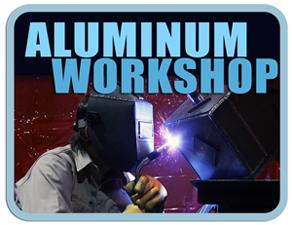President
- FMA
- The Fabricator
- FABTECH
- Canadian Metalworking
Categories
- Additive Manufacturing
- Aluminum Welding
- Arc Welding
- Assembly and Joining
- Automation and Robotics
- Bending and Forming
- Consumables
- Cutting and Weld Prep
- Electric Vehicles
- En Español
- Finishing
- Hydroforming
- Laser Cutting
- Laser Welding
- Machining
- Manufacturing Software
- Materials Handling
- Metals/Materials
- Oxyfuel Cutting
- Plasma Cutting
- Power Tools
- Punching and Other Holemaking
- Roll Forming
- Safety
- Sawing
- Shearing
- Shop Management
- Testing and Measuring
- Tube and Pipe Fabrication
- Tube and Pipe Production
- Waterjet Cutting
Industry Directory
Webcasts
Podcasts
FAB 40
Advertise
Subscribe
Account Login
Search
Aluminum Workshop: Aluminum TIG with DCEN
- By Frank Armao
- November 6, 2014
- Article
- Aluminum Welding
Q: I do a lot of aluminum GTAW, and I have always used alternating current (AC). Recently a friend told me that I can GTAW aluminum using direct current electrode negative (DCEN). Is this true?
A: Yes, it is true, but using DCEN requires some changes in the process. Let’s find out what they are.
When GTAW was first developed for aluminum, it was called heliarc welding. Used extensively in the 1940s and the 1950s, it required DCEN and pure helium shielding gas. Then people realized that there were advantages to using AC for aluminum GTAW.
In the GTAW process, the electrode negative (EN) current provides maximum penetration, which is highly desirable. But it doesn’t provide any arc cleaning characteristics. The electrode positive (EP) current provides cathodic arc cleaning of the aluminum—it actually strips the oxide from the surface of the aluminum in the area that is impinged upon by the arc.
If you make an AC aluminum GTAW, you should see a narrow stripe which is bright but frosty on each side of the weld. This area, as well as the weld area, has been cleaned by the EP component of the current. (Since GMAW also uses EP, you also see these stripes, but that’s a topic for another article.)
AC welding has two disadvantages. First, there is reduced penetration. Second, since the EP current puts a lot of heat back into the tungsten electrode, you need to use a larger-diameter tungsten, which is usually used with a ball on the end. DCEN aluminum GTAW provides significantly more penetration than AC, but you need to use 100 percent helium shielding gas to make the process stable. Argon is not a suitable shielding gas when using DCEN because the EN current and helium shielding gas do not provide any arc cleaning properties to remove oxides from the surface. As a result, you would have to be much more diligent with preweld cleaning procedures.
In addition to increased penetration, the other advantage of DCEN welding is being able to use a smaller-diameter tungsten electrode. Since much heat goes back into it, a smaller-diameter tungsten electrode with a pointed tip works very well.
DC GTAW can work very well on aluminum, so don’t be afraid to try it. Just be aware that the technique is different than that used for AC. I recommend that you practice for a while before you decide to use it on actual components.
About the Author

Frank Armao
Aluminum Consulting Inc.
440-479-0239
About the Publication
Related Companies
subscribe now

The Welder, formerly known as Practical Welding Today, is a showcase of the real people who make the products we use and work with every day. This magazine has served the welding community in North America well for more than 20 years.
start your free subscription- Stay connected from anywhere

Easily access valuable industry resources now with full access to the digital edition of The Fabricator.

Easily access valuable industry resources now with full access to the digital edition of The Welder.

Easily access valuable industry resources now with full access to the digital edition of The Tube and Pipe Journal.
- Podcasting
- Podcast:
- The Fabricator Podcast
- Published:
- 04/16/2024
- Running Time:
- 63:29
In this episode of The Fabricator Podcast, Caleb Chamberlain, co-founder and CEO of OSH Cut, discusses his company’s...
- Trending Articles
Sheffield Forgemasters makes global leap in welding technology

ESAB unveils Texas facility renovation

Engine-driven welding machines include integrated air compressors

The impact of sine and square waves in aluminum AC welding, Part I

Compact weld camera monitors TIG, plasma processes

- Industry Events
16th Annual Safety Conference
- April 30 - May 1, 2024
- Elgin,
Pipe and Tube Conference
- May 21 - 22, 2024
- Omaha, NE
World-Class Roll Forming Workshop
- June 5 - 6, 2024
- Louisville, KY
Advanced Laser Application Workshop
- June 25 - 27, 2024
- Novi, MI



























